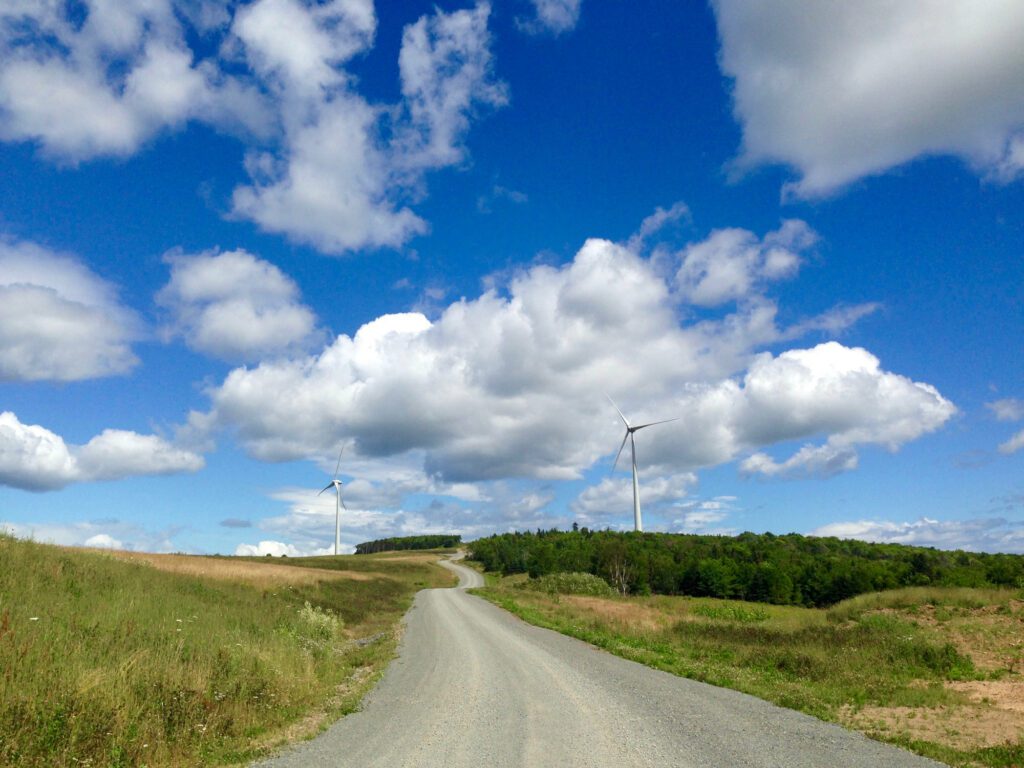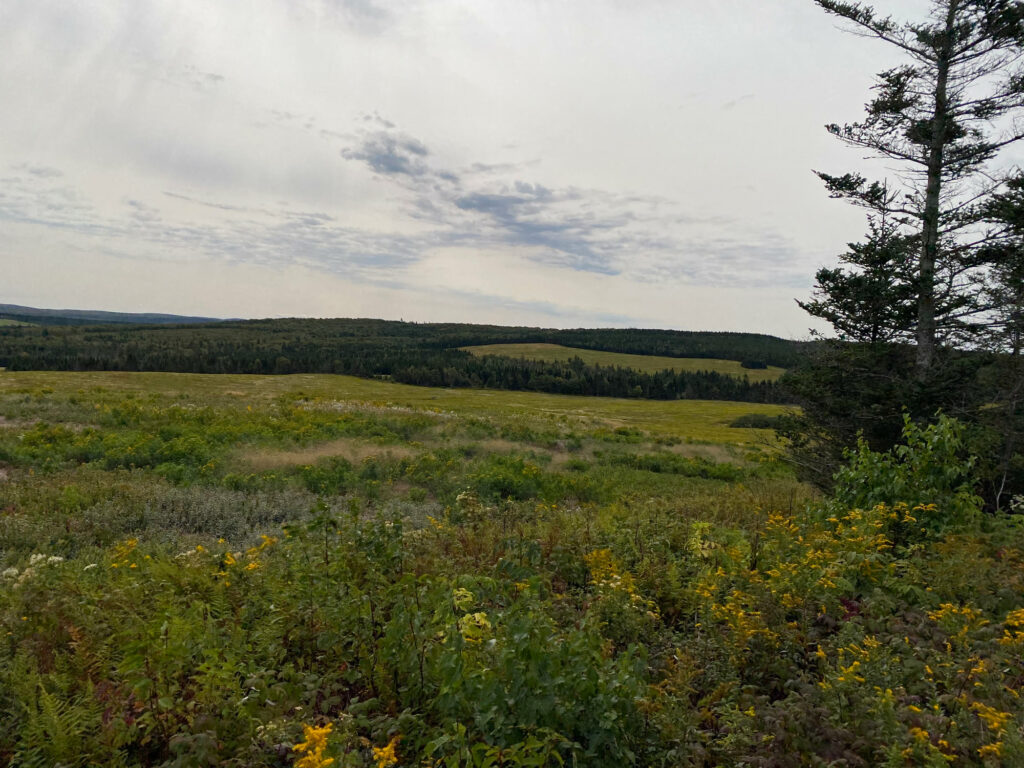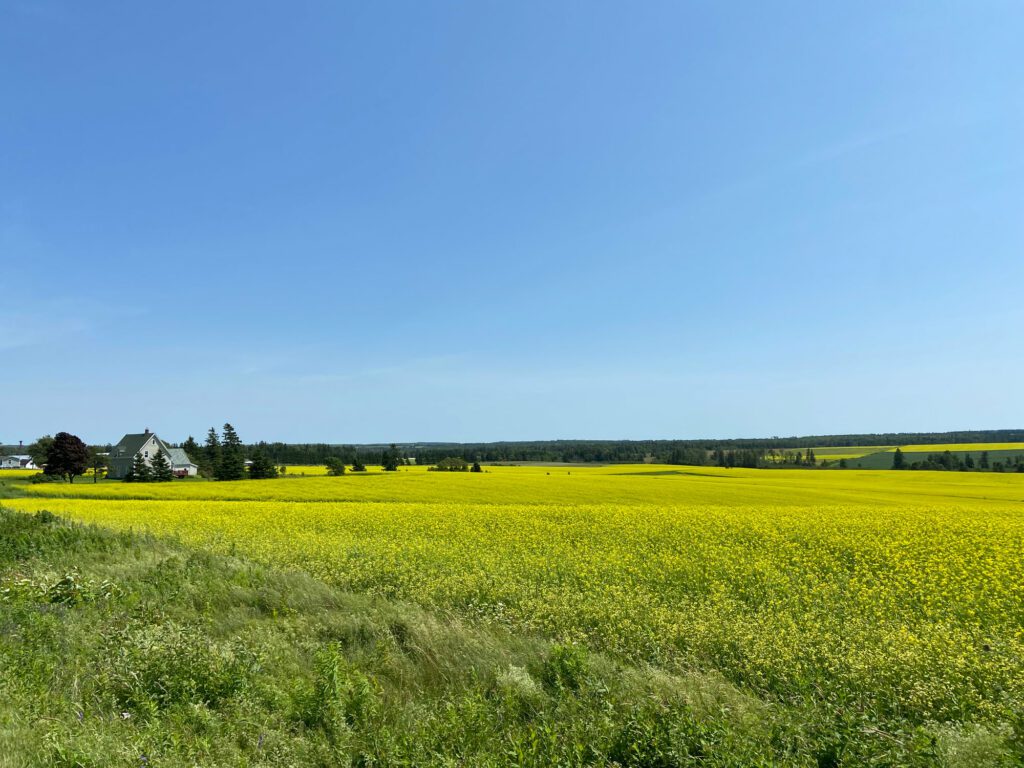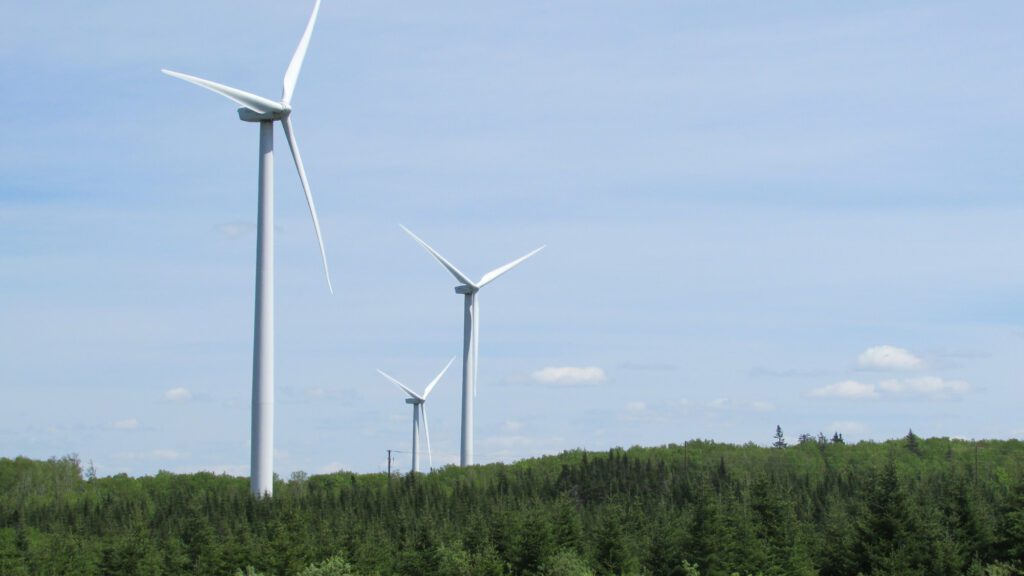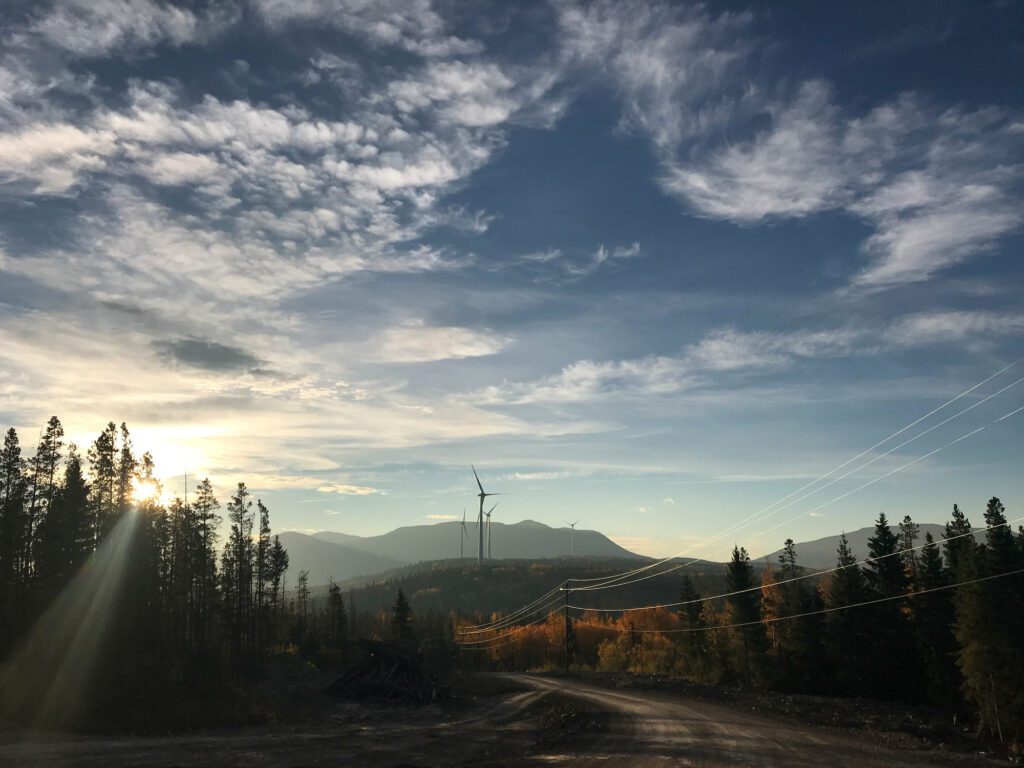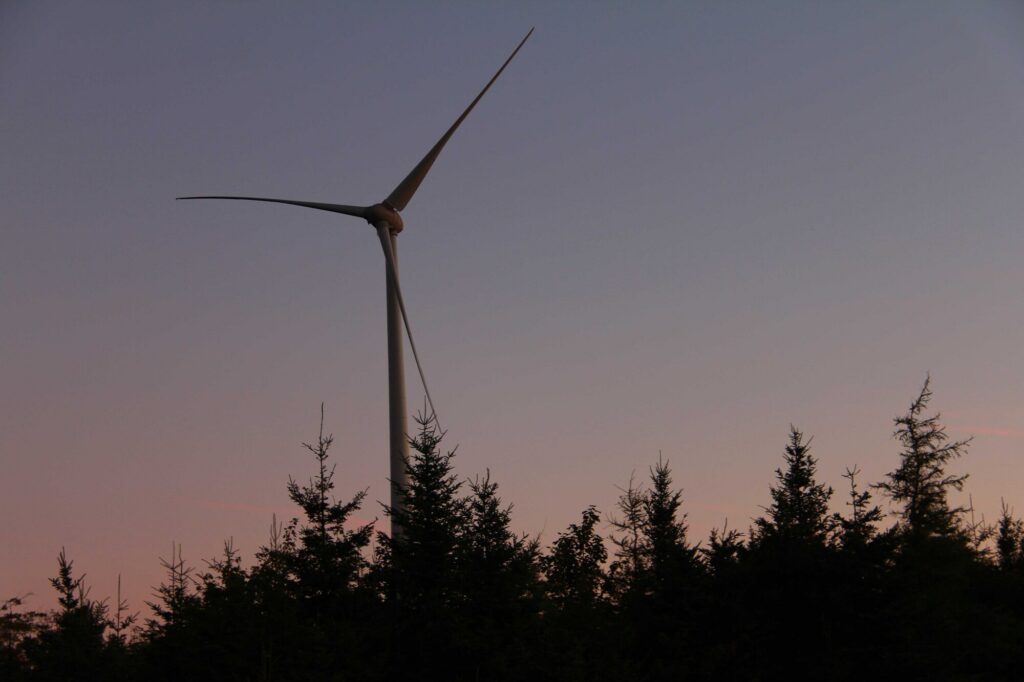Welcome to the website for the proposed Wejipek Wind Project! This website was created to provide information to community members, First Nations, government, and other stakeholders about the proposed project. Natural Forces is committed to meeting with stakeholders throughout the lifetime of the project. Information sessions and other community engagement activities are planned for this project – the website will be updated as information becomes available.
About The Project
The proposed Project is being developed and will be owned by the Wejipek Wind Farm Limited Partnership (the Proponent), a partnership between Lennox Island First Nation and Natural Forces Developments.
The proposed Wejipek Wind Project is located in Epekwitk (Prince Edward Island), the ancestral and unceded territory of the Mi’kmaq People. Natural Forces acknowledges that working on these lands is a privilege that comes with a great deal of responsibility. The proposed Project will have an installed capacity between 12 and 18 MW representing three wind turbines. The wind turbines will have maximum heights of approximately 200 m.
The Project is proposed on privately owned lands in Prince County, approximately 1 km south of Middleton and 3 km southwest of Kinkora. The site lands are largely used for agricultural activities and have some existing access roads for this purpose. This location was chosen due to optimal windspeeds, distance from residences, and minimal environmental constraints.
Project Updates
As we develop this project, we are committed to providing the public with frequent updates and the results of our environmental studies in this section.
- July 2022 – Environmental studies began
- June 2023 – A meteorological tower was installed on site to collect wind data
- July 6 2023 – First community meeting with Lennox Island First Nation at John J Sark Memorial School
- August 22 2023 – First public information session in Kinkora
- January 2024 – Secondary wind remote-sensing instrumentation (SoDAR) was deployed to validate and refine the data collected by the meteorological tower
- January 22 2024 – The project’s Environmental Impact Statement was submitted to the Department of Environment, Energy and Climate Action
- February 10 2024 – Natural Forces attended Lennox Island’s Annual Band Meeting to discuss the project with community members
- February 12 2024 – Second public information session in Albany
Who is proposing this project?

Lennox Island First Nation is the proud home of the Epekwitnewaq Mi’kmaq (Mi’kmaq People of PEI). Approximately 450 residents live on this island in Malpeque Bay off the northwest coast of Epekwitk with an access point via bridge. Lennox Island believes in achieving energy sovereignty through developing and owning renewable energy projects.

Natural Forces
Natural Forces is a private independent power producer that delivers renewable energy projects in partnership with local communities across Canada, Ireland and France. Established in 2001 in Halifax, Nova Scotia, Natural Forces remains a small company with big values and big ambitions.
Natural Forces develops, constructs, owns, and operates wind, solar, hydro and storage projects with Indigenous communities, universities, municipalities, and local community funds. Partnering with local communities for these projects not only generates clean and renewable electricity but delivers local economic prosperity and raises awareness of the challenges of climate change.
Why here?
When developing a wind project, it is crucial to find the most suitable location and community to host it. To do so, there are four main factors to consider during the site-finding phase of development:
- Wind resource
- Distance to existing electrical and civil infrastructure
- Environmental sensitivity
- Socio-economic concerns
Prince Edward Island has excellent wind resources, so generating electricity is feasible in many locations around the province. Factors other than the strength and consistency of the wind must be taken into account when considering a site, such as proximity to the electricity grid, road access, ecology, archaeology, and cultural significance, proximity to residential dwellings, and health concerns.
The location of the Wejipek Wind Project was selected after a thorough review of all of these factors.
Project Benefits
- Generate enough electricity to power approximately 4,000 PEI homes annually at 12 MW.
- Provide annual tax revenue over the life of the Project.
- Create local employment and contracting opportunities during the development, construction, operation, and decommissioning phases of the Project.
- Provide own-source revenue to Lennox Island First Nation through Project ownership.
- Increase revenue to local businesses due to economic spinoff from Project activities.
- Produce emission-free electricity on Island that will both increase energy security and displace generation from fossil fuels, thereby reducing greenhouse gas emissions.
- Assist the province of Prince Edward Island in meeting its renewable energy target of achieving net zero energy by 2030.
- Stabilize energy costs for Maritime Electric customers by increasing electricity generation sources with fixed-cost contracts.
Public & Stakeholder Engagement
The development of wind energy in PEI provides a clean and stable source of energy and positively impacts local communities in a variety of ways. These include economic spinoff through the increase in demand of local goods and services, and job creation mostly notably during the construction phase. Natural Forces is committed to engaging with all stakeholders and stakeholder groups throughout the lifetime of the project, as we value community input greatly. Below are details on the newsletters that have been sent to our stakeholders, as well as summaries of the information that has been shared at our open houses. Interested in receiving our newsletters? Sign up here!
Newsletters
Natural Forces has engaged with, and continues to engage with, stakeholders through a number of avenues, including newsletters. Each of the newsletters circulated to date are linked below:
Information Session
Natural Forces will hold information sessions to provide an opportunity for the community to engage with Natural Forces staff. All of the information presented will be uploaded here.
The first information session was held on August 23, 2023 in Kinkora. Click here to see the information session handout.
We hosted a second information session on February 12, 2024 at the Albany Community Centre. Click here to see the presentation.
What is the process?
1
Development
(Current Stage)
- Assess the wind resource
- Survey for environmentally sensitive features
- Optimize turbine location to capture the wind efficiently and minimize impact on sensitive features
- Begin consultation with regulators and the public
- Conduct and present the Environmental Impact Statement for environmental approval
- Apply for road, work and construction permits
2
Construction
- Clear trees for roads and turbine pads
- Build access roads and pad areas
- Pour the turbine foundation
- Assemble the wind turbine
- Connect to the Maritime Electric’s grid
3
Operation
- Commission the wind turbines to start producing power
- Conduct post-construction wildlife monitoring
- Monitor remotely for real time alerts when additional maintenance is needed
- Operate for 25 years
4
Decommission or Retrofit
- Assess wind turbines after 25 years
- Decommission wind turbines within 12 months of stopping operations
- Reclaim the site to its former state OR
- Receive approvals and permits to retrofit the turbine to continue harnessing energy
Environmental Impact Assessment
In PEI, any wind projects that exceed 1 MW in size are required to submit a provincial environmental impact statement (EIS). All wind turbine project proposals will include a means for transmitting the power, as well as a proposed power corridor route from the utility. During this process, an entire committee made of provincial and federal agencies evaluate the location and overall impact of the project on the surrounding environment and the public.
As the Wejipek Wind Project will produce up to 18 MW of electricity, it is subject to an EIS.
The Proponent submitted a summary description of the Project and environmental assessment methodologies to the province for review on July 21, 2023. This scoping document was reviewed by the Technical Review Committee (TRC), who provided written feedback to the Proponent on October 23, 2023. Feedback from the TRC has been incorporated into the EIS.
To fully assess the potential environmental and socio-economic impacts of the project, the following comprehensive studies were conducted:
- Wetlands and watercourses
- Vegetation
- Wildlife and habitat
- Bats
- Breeding and migratory birds
- Archaeology
- Sound levels
- Shadow flicker
Results from these studies were compiled in the EIS that was submitted to the province on January 22, 2024. The full EIS document and the associated studies are available for download here.
Sound Levels
The most significant factor when limiting sound impacts to nearby residences is the way wind turbines are sited initially. As such, the proposed wind turbine locations are more than 800 m from any residence. Based on this siting, Natural Forces assessed the impact of sound levels from the proposed Wejipek Wind Project on nearby homes. This assessment uses industry best practices to model how the sound created by the wind turbines will travel over the landscape.
Natural Forces engaged a third-party consultant to review the methodology used to carry out this modelling and to validate the results. The company Aercoustics Engineering concluded that the methodology used by Natural Forces is appropriate and provides conservative results, likely overestimating the expected sound levels. Results of the modelling show that sound levels potentially experienced by nearby receptors during the Project operation would be below 40 decibels. Under certain climatic conditions for short periods of time, the model estimates a maximum sound level at a residence of 40.9 decibels, which is comparable to quiet library sound. The map below visually shows the results of the sound modelling. Sound Comparisons – 40 decibels: quiet library sounds, 50 decibels: refrigerator, 60 decibels: electric toothbrush.
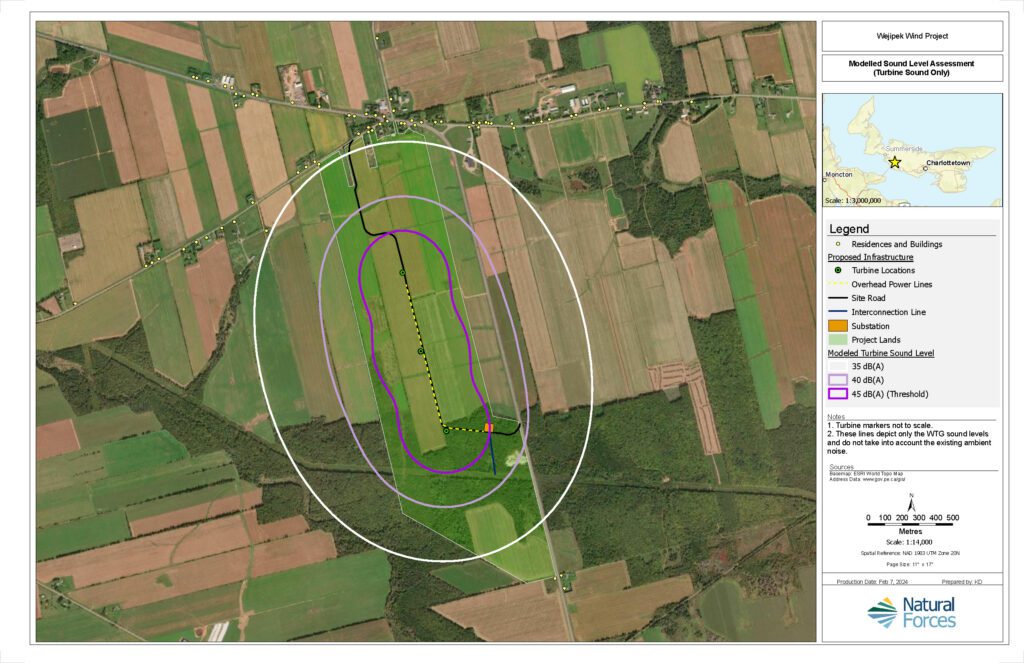

Frequently Asked Questions
Natural Forces undertakes rigorous environmental impact assessments ahead of construction to determine existing environmental sensitivities and potential impacts on the project to the environment. This information will be reviewed by provincial government officials and will be open for public comment.
The proposed turbines will be set back at least 800 m from all cabins and houses.
For this project, Natural Forces leased land from private landowners. Over the course of several years, we have developed trusted relationships with the landowners and in all instances the land remains in the ownership of the landowner and is leased for the duration of the project. No land has been leased from unwilling landowners.
During construction, Natural Forces makes every attempt to hire local contractors, using our in-house construction management company, Natural Forces Construction, to ensure smaller contractors are able to participate.
Wind turbines have moving parts and therefore some sound can be expected. However, well-designed wind turbines are generally quiet in operation, and compared to the noise of road traffic, trains, aircraft, and construction activities, the sound from wind turbines is very low. As wind turbine technology has evolved, the sounds emitted have decreased. The further away you are from a project, the less sound it will make. This site will likely have trees and other barriers that would break a lot of the sound before it reaches homes. A typical wind project would have a noise level of between 35-45 decibels. For reference, the compressor of a refrigerator produces 40-45 decibels. (Check out the Energy Nova Scotia Wind Page for more information). Stories of excessive noise often come from areas where the turbines are very close to homes. Natural Forces follows the minimum standards for distance from residences laid out by local regulations, or a typical minimum of 1KM.
For more information contact:
Myriam Mora, Project Manager
902-483-9592 or 902-422-9780
community@naturalforces.ca
